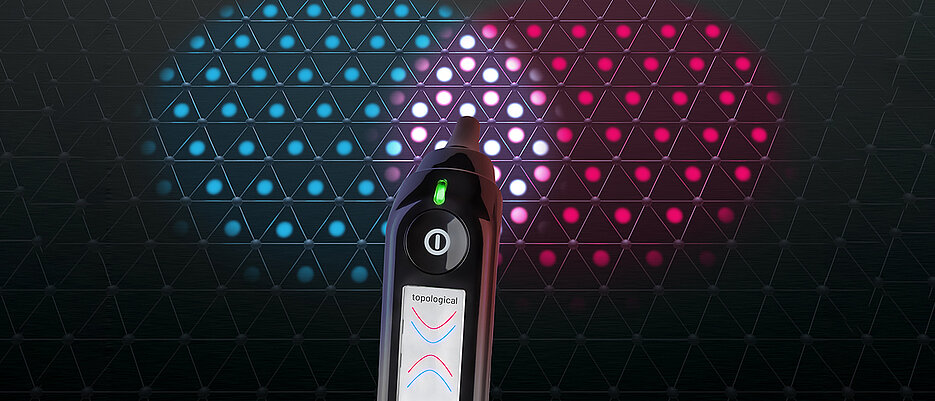博文
量子物理学的方法里程碑
 精选
精选
||
量子物理学的方法里程碑
诸平
据德国维尔兹堡大学(University of Würzburg, D-97074 Würzburg, Germany)2024年5月16日报道,量子物理学的方法里程碑(Method Milestone for Quantum Physics)。拓扑二维材料的快速测试: 来自德国维尔茨堡-德累斯顿量子物质的复杂性和拓扑结构(Complexity and Topology in Quantum Matter简称ct.qmat)卓越集群(Würzburg-Dresden Cluster of Excellence ct.qmat)的研究人员,开发了一种更容易、更快速地检测二维拓扑材料的方法。相关研究结果于2024年5月6日已经在《物理评论快报》(Physical Review Letters)杂志网站发表——Jonas Erhardt, Cedric Schmitt, Philipp Eck, Matthias Schmitt, Philipp Kessler, Kyungchan Lee, Timur Kim, Cephise Cacho, Iulia Cojocariu, Daniel Baranowski, Vitaliy Feyer, Louis Veyrat, Giorgio Sangiovanni, Ralph Claessen, Simon Moser. Bias-free access to orbital angular momentum in two-dimensional quantum materials. Physical Review Letters,2024, 132: 196401. Published 6 May 2024. DOI: https://doi.org/10.1103/PhysRevLett.132.196401
参与此项研究的除了来自维尔兹堡大学的研究人员之外,还有来自英国钻石光源(Diamond Light Source, Harwell Science and Innovation Campus, Didcot, United Kingdom)、意大利的里雅斯特的埃莱特纳- 辛克洛特罗纳公司(Elettra-Sincrotrone, S.C.p.A, Trieste, Italy)、意大利的里雅斯特大学(Università degli Studi di Trieste, via A. Valerio 2, Trieste, Italy)、德国尤利希研究中心(Forschungszentrum Jülich GmbH / Jülich Research Centre, Jülich, Germany)、德国杜伊斯堡-埃森大学(Faculty of Physics and Center for Nanointegration Duisburg-Essen (CENIDE), Universität Duisburg-Essen, Duisburg, Germany)、德国莱布尼茨固体和材料研究所(Leibniz Institute for Solid State and Materials Research, IFW Dresden, Dresden, Germany)以及法国图卢兹的国家强磁场实验室(Laboratoire National des Champs Magnétiques Intenses, CNRS-INSA-UJF-UPS, UPR3228, 143 avenue de Rangueil, Toulouse, France)的研究人员。
拓扑量子材料被誉为未来技术进步的基石。然而,验证它们的卓越品质一直是一项长期的工作。然而,ct.qmat卓越集群的研究人员现在开发了一种实验技术,通过快速测试系统地识别二维拓扑材料。这一突破可能有助于加速这类新兴材料的发展。.
前沿研究是高度复杂和耗时的(Cutting-edge Research is Highly Complex and Time-consuming)
2007年,维尔茨堡-德累斯顿量子物质的复杂性和拓扑结构(ct.qmat)卓越集群的创始成员劳伦斯·莫兰坎普(Laurens W. Molenkamp)教授,提供了拓扑绝缘子(topological insulators)的第一个实验证明,这是一类新材料。这些材料之所以引人注目,是因为尽管它们的内部行为像电绝缘子,但它们在表面导电而没有任何电阻。自从这一突破性的发现以来,引起全球材料科学家对这些材料高度关注。这是因为它们在潜在的材料革命中发挥了关键作用,以及它们在量子技术中有前途的应用,比如开发功能强大、节能、不产生废热的“冷芯片”("cold chips")。
“目前,通过实验检测拓扑绝缘体需要高度复杂的研究。它需要一个庞大的团队和大量的时间来准备材料样本。此外,成功的检测永远不能保证,”ct.qmat维尔兹堡发言人拉尔夫·克莱森(Ralph Claessen)教授说。
材料革命的快速测试(Rapid Test for the Materials Revolution)
但现在,ct.qmat在维尔兹堡的研究团队设计了一种系统的方法,使用一种简单得多的测量技术,在创纪录的时间内识别二维拓扑量子材料。来自维尔兹堡大学(Julius-Maximilians-Universität of Würzburg简称JMU Wurzburg)的项目负责人西蒙·莫泽(Simon Moser)博士解释说:“基本上,除了一个有前途的材料样本,你真正需要的是特殊的X射线。所需的光粒子应该是高频和圆形极化的(circularly polarized),这意味着它们具有角动量。这可以通过使用任何同步加速器光源来实现。例如,我们的样本在的里雅斯特的同步加速器(Elettra Sincrotrone in Trieste)和英国牛津郡哈维尔科学与创新校区(Harwell Science and Innovation Campus in Oxfordshire)的英国国家同步加速器科学设施钻石光源(Diamond Light Source, UK’s national synchrotron science facility)进行了辐照。”
这听起来很简单,但实际上是研究拓扑量子材料的重大突破。西蒙·莫泽指出:“如果你在同步加速器上固定一个槽,你可以在大约一周内确定一种材料是否是拓扑绝缘体。如果用传统的方法,这至少需要花费完成一篇博士论文的时间。”
二向色性光致旋转成功(Spinning Success with Dichroic Photoemission)
这种新型快速检测方法的实质在于二向色性光电发射(dichroic photoemission)。材料样品多次暴露于不同偏振的高频光下。例如,最初,只有顺时针旋转的电子从材料中释放出来。随后,只有逆时针旋转的电子被释放。
利用二向色光发射探测电子的不同旋转方向,从而揭示它们的拓扑结构并不是一个新的想法。在2023年,另一个来自维尔兹堡ct.qmat团队首次使用这种方法分析了戈薇金属(kagome metal)的拓扑结构。西蒙·莫泽解释他的团队的新方法时说:“他们使用圆形光电发射来研究戈薇金属。我们专注于方法论,并开发了一种诀窍,现在总是有效的,而并非偶然的。我们的快速测试系统地使电子的拓扑结构可见。”
展望(Outlook)
由于研究人员长期以来一直在研究二维量子材料的独立性,他们也使用这种材料来开发快速测试方法。此外,他们已经将这一原理应用于其他材料。最近的一项实验涉及辐照铋烯(Bismuthene)样品,数据将很快进行分析。
上述介绍,仅供参考。欲了解更多信息,敬请注意浏览原文或者相关报道。
The demonstration of a topological band inversion constitutes the most elementary proof of a quantum spin Hall insulator (QSHI). On a fundamental level, such an inverted band gap is intrinsically related to the bulk Berry curvature, a gauge-invariant fingerprint of the wave function’s quantum geometric properties in Hilbert space. Intimately tied to orbital angular momentum (OAM), the Berry curvature can be, in principle, extracted from circular dichroism in angle-resolved photoemission spectroscopy (CD-ARPES), were it not for interfering final state photoelectron emission channels that obscure the initial state OAM signature. Here, we outline a full-experimental strategy to avoid such interference artifacts and isolate the clean OAM from the CD-ARPES response. Bench-marking this strategy for the recently discovered atomic monolayer system indenene, we demonstrate its distinct QSHI character and establish CD-ARPES as a scalable bulk probe to experimentally classify the topology of two-dimensional quantum materials with time reversal symmetry.
https://m.sciencenet.cn/blog-212210-1434552.html
上一篇:20年前的分子预测成真:化学家终于成功地合成了一种不寻常的、难以捉摸的分子
下一篇:Nature:硼酸驱动的酶产生突破性的催化作用
